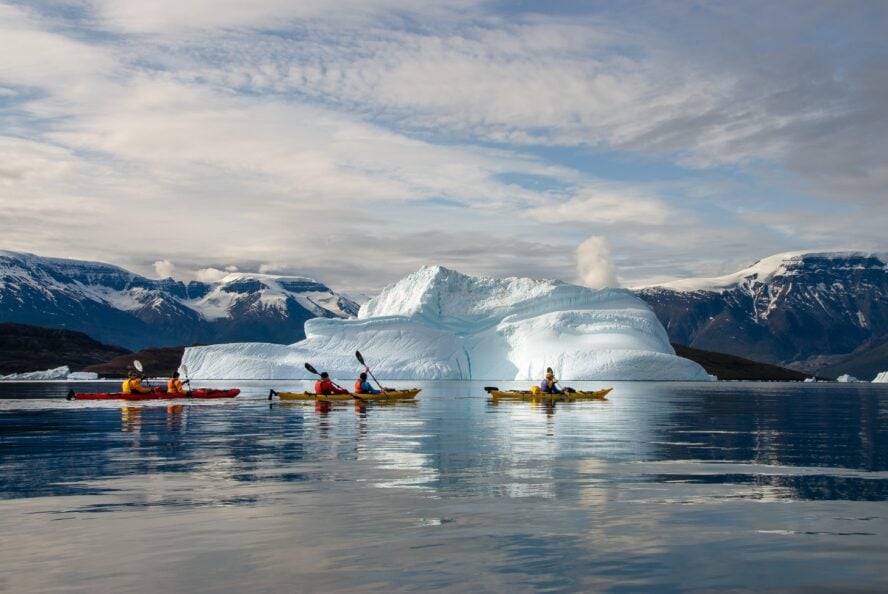It was my retired city slicker father’s budding interest in kayaking that first got me intrigued. As the athletic one in the family I never felt limited by sports, but the fear of flipping and ending up “in the drink” held me back for years
Seeing my dad balance with ease—while simultaneously smoking a cigar and casting a spinner rod, mind you—I realized, if he can do it, so can I. Those first kayaking trips with dear old Pop led me down a rabbit hole of watersports, and now I can’t get enough.
If you’ve wanted to start kayaking too, but have felt held back for one reason or another, know that there’s always a launch point for your interest and comfort level. And once you get going, kayaking can really take you anywhere you want to go, from leisurely paddles in your hometown pond to voyages to parts unknown.
To help you get started, here are beginner kayaking tips so you can feel confident dipping in your toe—and paddle—for the first time.
(Oh, about flipping: it almost never happens. It’s been empowering to overcome that fear!)
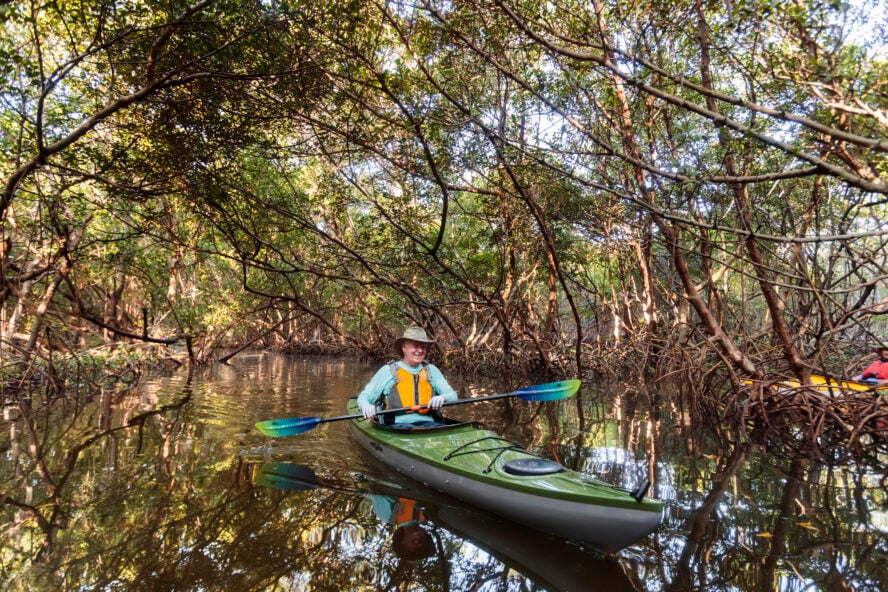
Kayaking Has Something for Everyone
Throughout a decade plus of commercially guiding and leading private trips, I have found that each person has their own goals and reasons for being out on the water.
For my dad, it symbolizes retirement—a leisure activity he started fairly late in life. For the earliest paddlers, it was undoubtedly about survival. For others, it might be a way to enjoy a bird watching day trip with the family or overnighting in the San Juan Islands in Washington (which are fabulous by the way). For me, it’s about finding equilibrium with my surroundings and stewarding these precious bodies of water.
In paddling, there is something for everyone. If you want to take baby steps because water makes you nervous, that’s okay. If you want to puff on a stogie while you drift downstream hardly paddling at all, great. In the end, you get to choose your own adventure!
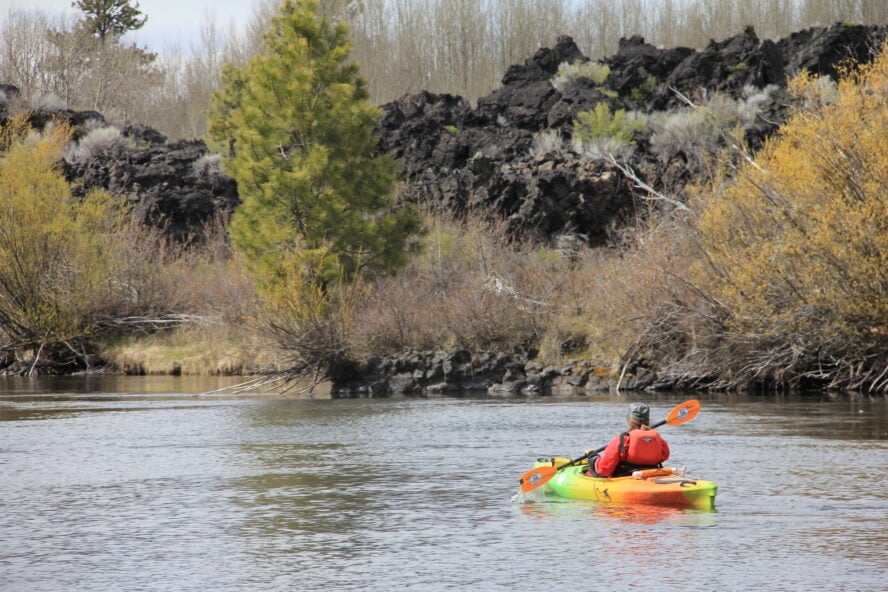
Whatever Floats Your Boat: The Different Types of Kayaking
There are many different types of waterways, each presenting their own challenges and considerations, especially when it comes to which raft you’ll use. In this article, we’ll specifically explore recreational flatwater kayaking, which is the most accessible to a novice.
Where to kayak for beginners
For the wet stuff, lakes are typically the most accessible because they tend to be stable. However, you want to be mindful of windy days. If you choose to paddle in light wind, I suggest you paddle into it first, that way it will be in your favor upon return. For rivers you’ll be paddling against a current getting back upstream, unless you plan a car shuttle for pick up at a downriver take-out point. When paddling in the ocean, be sure to choose a sheltered bay or lagoon. Avoid white caps and again, be careful of the wind.
In many cases, there is a time of day where conditions are mildest. Wind usually (but not always) kicks up in the afternoon, so mornings and evenings can be the calmest part of the day. Talk to locals to find out specifics.
As you advance, kayaking happens on moving water or water with a strong current. Whitewater kayaking (paddling down rapids), play boating (facing upstream and surfing in a very compact kayak) or slalom race kayaking (popular on the east coast and in Europe) are worth exploring.
Know the local regulations
Permits and passes are another set of considerations for where to kayak. In Oregon, for example, an Aquatic Invasive Species Prevention Permit is required, in addition to a State Park, National Forest and other governing body pass. An Aquatic Invasive Species Permit aims to improve and implement outreach, education and enforcement efforts to boaters in the areas that are most threatened by invasive species. Setting sail for the first time with a class, tour or personal guide hired by a local boating shop simplifies things because they will have the proper permits and passes.
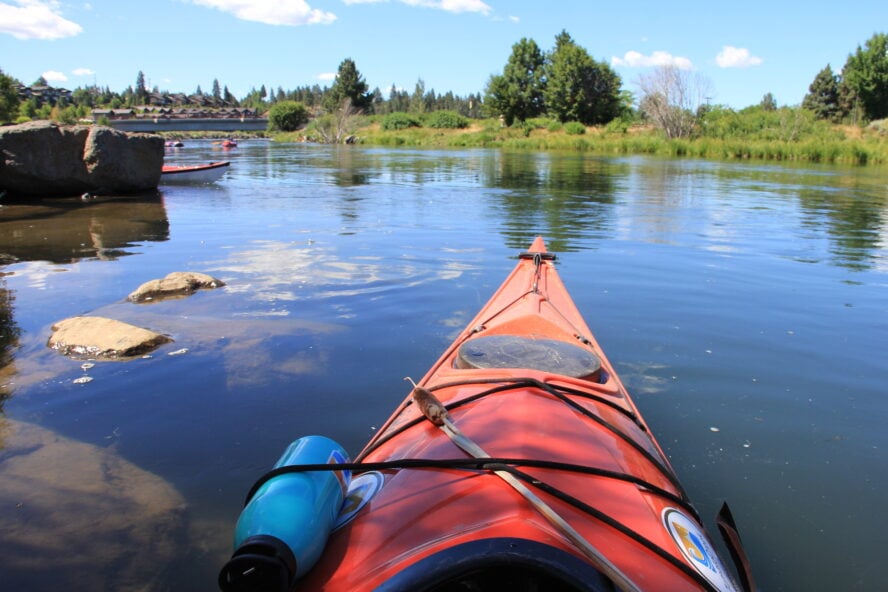
Meet your steed: Best type of kayaks for a beginner
In terms of styles, recreational flat water kayaks are the Cadillacs (and are sufficient for the terrain above). Generally speaking, they have the largest cockpits, are wide and long, and thus, stable.
There are two main types of recreational flat water kayaks: inflatable and hardshell. Inflatable kayaks are made of PVC, hypalon or some form of malleable polymer which can be easily inflated and deflated. Inflatables are friendly to beginners, easily stored and don’t get damaged as easily by river rocks or in transportation.
Hard shells, or kayaks with rigid bodies, are made of solid plastic or fiber-glass. This style performs with more precision—it is responsive to every movement, maneuver and stroke. The downside is that it can incur damage from rocks or obstacles more readily.
The latest advancement in kayaking is the inflatable packraft which is made from an ultra-lightweight fabric. They are designed to be very light, naturally, and for packability, however the tradeoff is that they are less robust compared to standard inflatables. These are excellent for hike-in backcountry adventures, such as fly fishing on an alpine lake.
You may be wondering, how does kayaking compare to canoeing?
Canoes are much heavier and are often longer than kayaks. The cockpit is bigger, can carry more weight, but is open with no decking (which means water can easily enter the vessel). It is also common for multiple people to travel in one canoe. Essentially, they are designed for different purposes.
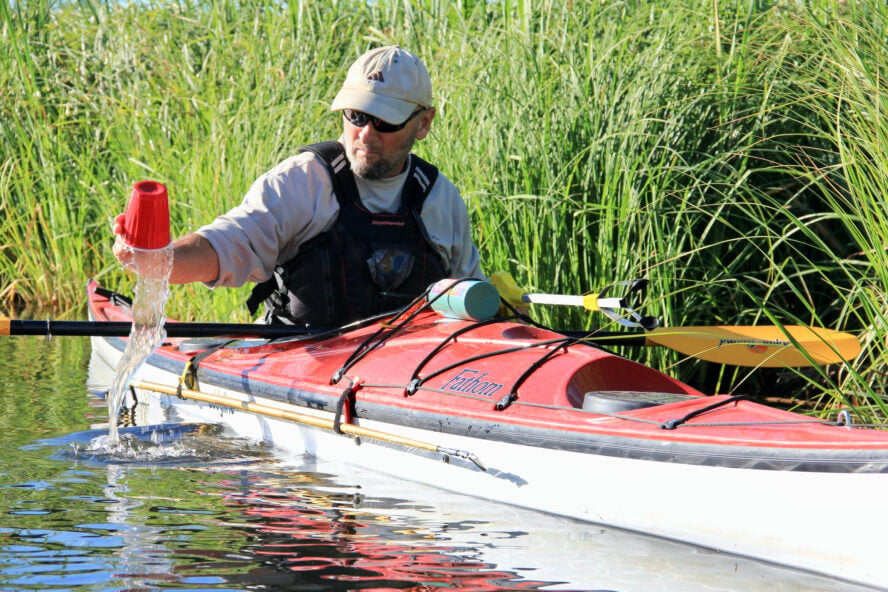
Kayaking 101: The Gear
Four of the five essential pieces of gear are intuitive. You’ll need: a kayak, a paddle, a life jacket (or personal flotation device, PFD), a utility water canteen of some sort, and drum roll… a rubbish bag.
Kayaks and paddles are obvious, while life jackets are a required piece of gear on most waterways, though you should check your State Marine Board for local regulations. Be sure to keep the PFD on board, if not on your body. Many injuries and deaths happen each year from paddlers who unexpectedly find themselves in the water. When these paddlers have life jackets on, their chances of fatality drastically shrinks. No matter how good a swimmer you are, it’s best to wear a life jacket when kayaking.
Continuing on, drinking water is critical on any adventure, boating or otherwise. Finally, why the rubbish bag? In case you find any objects that don’t belong in the waterway you’re navigating, i.e., trash, you’ll be able to secure them in the bag. Side note: our waterways tend to collect garbage, so think of every trip as an opportunity to do a little cleaning up.
For you first trips, don’t feel like you need to shell out for new equipment. There are plenty of local outfitters that have rental options.
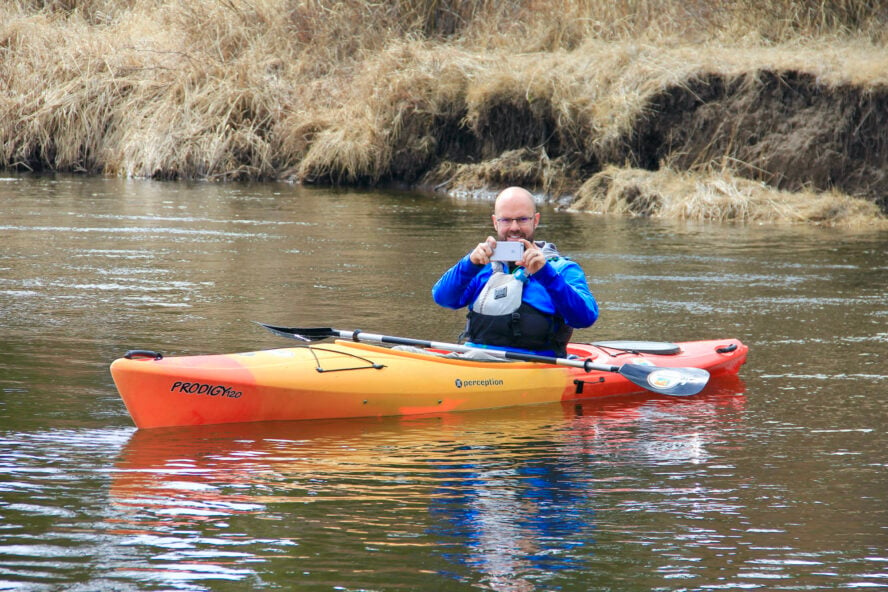
An insider kayaking tip: Nice-to-have equipment
The main thing is to stow everything you bring so that it won’t yard sale if you capsize. It’s a rookie move you don’t want to make.
As unlikely as it might seem, imagine flipping and seeing all your snacks and treats, utility water canteen, smartphone, swiss army knife—and whatever else you packed in your cockpit—floating about unhinged. This is a major stewardship no-no. More advanced kayaks have a storage compartment or bungee tiedowns where you can keep your stuff.
I recommend using a dry bag to put everything in and keeping your smartphone in a transparent dry sleeve around your neck. These are handy for protecting the phone from the water, especially while taking photos (which you’ll inevitably want to do).
Other nice-to-haves include sunglasses with Croakies (so you don’t lose them overboard) and easy to eat snacks like nut butter packets, gummies or dried fruit.
What you bring on board can get into the waterways (seriously)
Where I’m from, there is an annual Deschutes River clean-up put on by the Upper Deschutes Watershed Council. Routinely, 100s of pounds of trash are taken out on these days. If you’re bringing something aboard, put it in a dry bag, and latch it with a carabiner or tie it down—so you can make sure you’ll be taking it home.
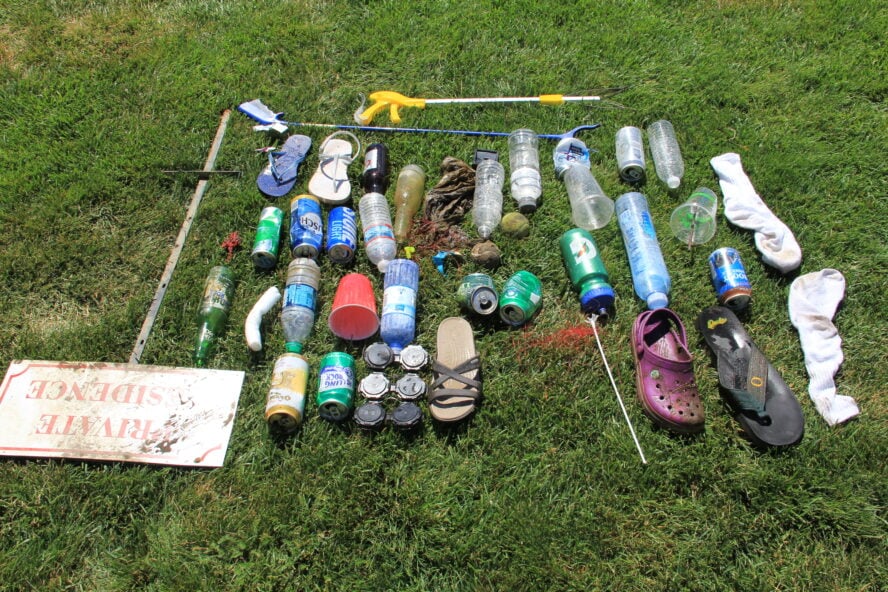
What to Wear Kayaking: Plan For a Wet Exit
Like many other outdoor sports, what you wear is critical when it comes to kayaking. As the saying goes, “don’t dress for the air temperature, play it safe and dress for submersion.”
That being said, as long as you avoid cotton or natural fibers and cover your skin, paddlers can make a lot of crossover outdoor clothing work. With melanoma scares ever-present, my dad and I are strict about wearing our lightweight synthetic sunshade hoodies and shorts, hats, sunscreen, sunglasses, and extra strappy footwear like Chacos or utility sandals. If the weather is meant to be a little chillier or I am out on an all-day paddle in the sun, I might wear leggings.
For warmth or rain protection, a windbreaker and rain pants work well. In more extreme cases, wetsuits and drysuits are the warmest, most technical and the highest dollar options.
Pro kayaking tip: Amid the tried and true, costumes over your kayak outfit are both socially acceptable and highly encouraged.
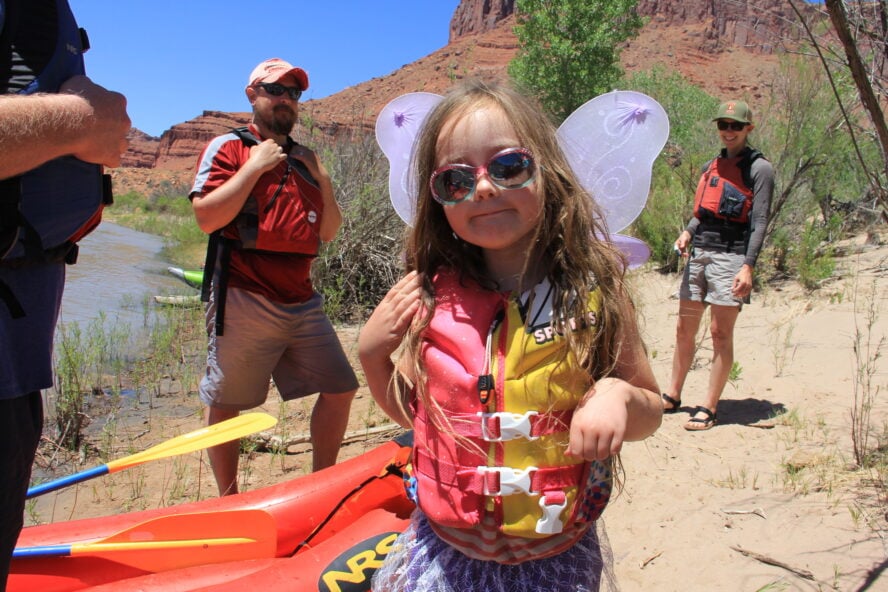
Let’s Get On the Water: Tips for Your First Time Kayaking
The best way to get started is to go with a friend or to take a lesson from a local outfitter. You may think, how hard could it be?, but having a professional on hand to show you the ins-and-outs makes all the difference.
For example, did you know many recreational kayaks have feet braces that can be adjusted for your height? And if your feet aren’t touching or adequately utilizing them you could be missing out on more power in your stroke? These are key kayaking tips and tricks an instructor will show you.
Another great way to get plugged into the kayaking scene is to check paddle shop listings in the spring. Many larger shops host a “Paddlefest”, a weekend full of activities and free demos from top brands like Eddyline and Current Designs.
Paddling for beginners: Basic strokes
The nuts and bolts of paddle strokes are the forward stroke and the backward, or reverse, stroke.
A forward stroke (put paddle blade in at the bow and twist back or pull), a reverse stroke (put blade in at the stern and twist forward or push). The reverse stroke is also used to slow the kayak down. These strokes are essentially the forward or backward, unwinding or winding of a corkscrew.
Once you get these down, try something a little more advanced: the draw. With the draw, you place the blade on your right or left and “draw” concentric circles in the water with the blade. You are doing it right if your boat is pulled toward your blade.
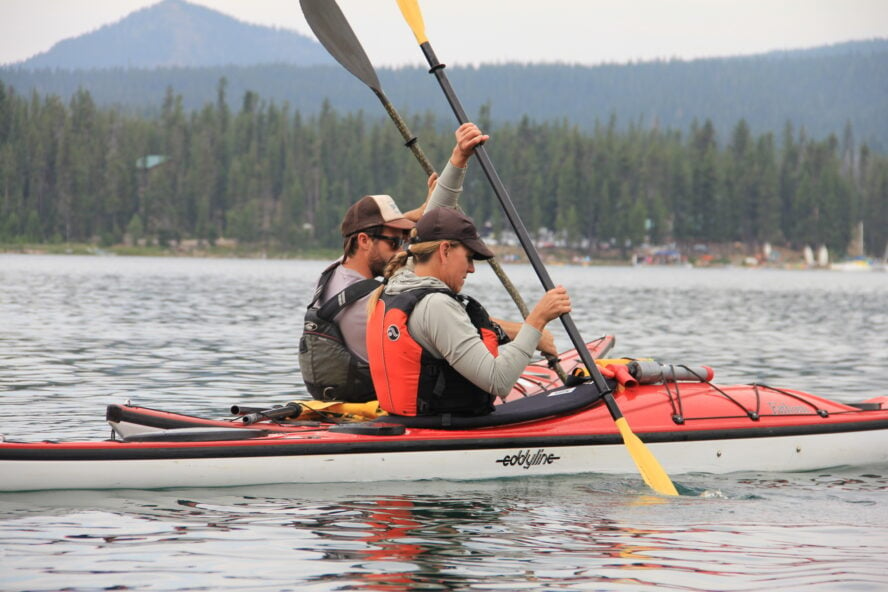
Launching and landing
There’s more than just the technique on the water, you need to know how to get into a kayak, and out too.
When launching from land, be mindful that your feet will get wet. Neoprene booties or Chaco style sandals are ideal for this. Alternatively, if you are paddling with a buddy, you may be able to talk them into launching you from dry ground thus avoiding wet feet.
It is also possible to launch from a dock. To safely and efficiently enter the cockpit from a dock, have a friend steady the bow or stern of your kayak. While you enter, keep your weight as low as you can.
Landing is far easier. Perpendicular to shore, with some momentum, run your kayak aground, into the shoreline. Alternately, paddle aside the dock and again have a person steady your boat as you exit, keeping your weight low.
Basic Kayaking Safety Tips
On a lark, during the biggest paddle outing my dad and I ever endeavored, we crossed the Columbia River at its narrowest point, perhaps 1,000 feet, to the mouth of the Klickitat River.
We enjoyed a leisurely day picking cliffed-out riverside black berries and checking out the local Osprey, Belted Kingfisher and Great Blue Heron. While the paddle across was mostly friendly, on the return, the waves and wind had kicked up and we fought an upriver current to get back.
All told, it was 30 minutes of stressful hectic maneuvering, and we were lucky it didn’t end in a capsize. When we landed we carried our burning biceps, ghost white faces and upset tummies to the beach and laid on shore counting our lucky stars. My dad especially.
Recounting the outing, as we often do, we call it Type Two Fun—more celebrated in retrospect as a memory, rather than in the moment.
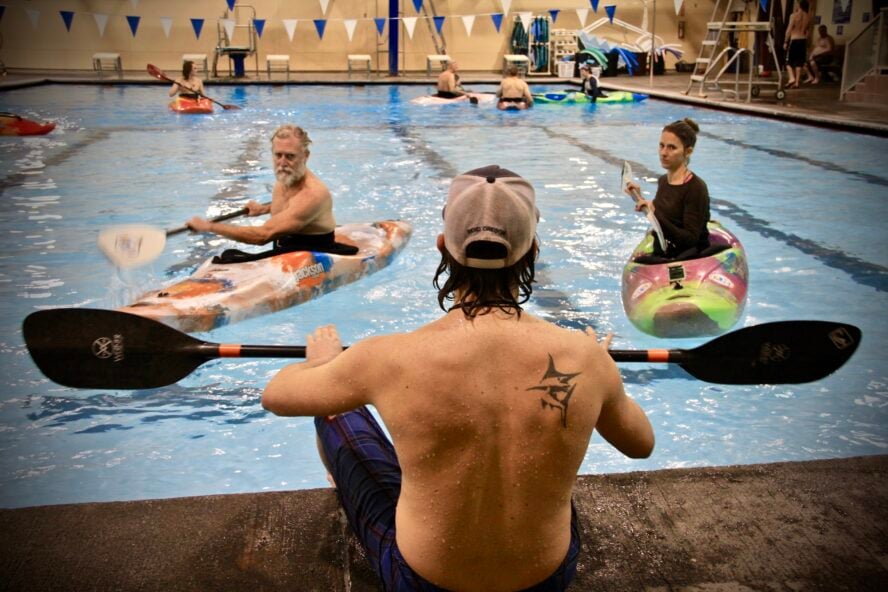
After this paddle trip, my Dad and I realized how dangerous kayaking can be. We did a major safety check and even took a kayak roll class together. Some of the items we now carry include a whistle, a tow line and a first aid kit (at the very least we have one in the car). Other safety equipment to look into as you progress is a basic touring safety kit which includes a bilge pump to clear the cockpit of water and a float bag which attaches to a paddle blade and helps a capsized kayaker re-enter the cockpit.
Bon voyage!
Once you learn the basics of kayaking a world of waterways can open up to you. Make sure to start small and safe, but as you advance you’ll gain all kinds of kayaking memories to be shared for years to come.
While I’ve paddled lakes and rivers as far and wide as Germany and New Zealand, my greatest kayaking love is traversing my home of Central Oregon. The novelty and miracle of floating through dry flood basalts and dusty high desert terrain never ceases to amaze.
You really can see the most incredible sites from the cockpit of a kayak.




